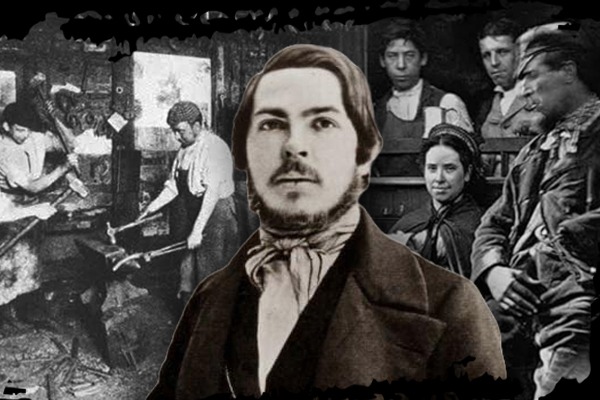The book “The Condition of Working Class in England” by Engels, is a seminal work in socialist literature, social science, social health and public health. Engels for the first time in history, corelates the deplorable health condition of the working class with their social and economic condition. Karl Marx read the manuscript of the book in 1844 after their first meeting, and was impressed by it. The foundation of political economy of health starts with this classical work. Rudolf Virchow, the eminent pathologist and one of the founders of social health had read this book and was influenced by it. Virchow’s report on the epidemic in Upper Silesia in 1848 bears the imprint of this seminal work of Engels. This book remains a reference book for all research scientists of social health and public health.
Engels was born in Barmen, Germany in 1820, to a wealthy family. At the age of 18, he was already involved in radical politics, he wrote two articles in the local paper anonymously on the condition of workers in mills and factories. In 1841, he had his military service in Berlin, where he was involved debating in Hegelian circles, discussing philosophy and published articles in a radical magazine. His parents were appalled by his radical political activities. They sent him to Manchester to work for his family’s textile business in 1842, at the age of 22. Manchester was the heart of industrial revolution of England, with many cotton mills. On his way to Manchester, he met Karl Marx, the editor of a radical magazine, for the first time.
He spent the next two years in Manchester. His parents had thought that a change of place and engagement in business activities will distract Engels. The young Engels was more interested in studying the living conditions of workers in Manchester. He met Mary Burns and Lydia Burns, two Irish sisters in Manchester, that becomes a lifelong association. Mary helped him visiting the areas where the poor workers lived. A period of interaction with workers, collecting data, newspaper clippings about the living and working condition of workers, and their health status. In 1844, on his return to Germany, he wrote the book and the book was published in German in 1845. An English edition was published only 42 years later in 1887.
This treatise is considered by some as ‘a neglected masterpiece’ (Hyman, 1962). This masterpiece portrays the living and working condition of the workers in the growing capitalist system of Victorian era and its effect on health of working class. Engel’s traces the source of the plight of the working class to the capitalist system, the production relation of owner and worker, and the profit motive of the system.
The book was dedicated “to the working classes of Great Britain”, and Engels wrote- “I wanted to see you in your own homes, to observe you in your everyday life, to chat with you on your conditions and grievances, to witness your struggle against the social and political power of your oppressors. I have done so. I forsook the company and dinner parties, the port wine and the champagne of middle classes and devoted my leisure hours almost exclusively to intercourse with plain Working-men.” In the preface he writes, “The condition of the working-class is the real basis and point of departure of all social movements of the present because it is the highest and most unconcealed pinnacle of the social misery existing in our day.”

Nineteenth century witnessed paradigm change in the political ad economic scenario of England. Industrial Revolution had ensued with large industries, coal mining, power looms and steam engines. England was leading in the race. Cities were the center of industrial activity; the population of cities grew exponentially. Capitalism destroyed the rural economy; the middle class was almost erased, and the rural population migrated to cities in search of employment. Only two classes existed, the rich and poor or the bourgeois and proletariat. The working class or the proletariat lived in crowded, unventilated, stinking, unhygienic ghettos in cities.
Engels describes the horrid condition in which the working class lived, “Every great city has one or more slums, where the working class is crowded together.” “These slums are pretty equally arranged in all the great towns of England, the worst houses in the worst quarters of the towns .. the streets are generally unpaved, rough, dirty, filled with vegetable and animal refuse, without sewers or gutters, but supplied with foul, stagnant pools instead.”
On the working-men’s dwellings of Manchester, he writes, “no cleanliness, no convenience, and consequently no comfortable family life is possible; that in such dwellings only a physically degenerate race, robbed of all humanity, degraded, reduced morally and physically to bestiality, could feel comfortable and at home.” The report of medical commission during epidemic of cholera in England paints the same picture. The clothing of working class in majority of cases was in bad condition. So was the food of the working class. “Where wages are less, meat is used only two to three times a week, and the portion of the potatoes and bread increases. Descending gradually, we find the animal food reduced to a small piece of beacon cut up with potatoes; lower still even this disappears, there remains only bread, cheese, porridge, and potatoes, until on the lowest round of the ladder, among the Irish, potatoes form the sole food.” “And if he gets nothing, he starves.”
To sum up the living condition, “these workers have no property whatsoever of their own and live wholly upon wages, which usually go from hand to mouth. Every working-men, even the best, are constantly exposed to loss of work and food, that is to death by starvation, and many perish in this way. The dwellings of the workers are everywhere badly planned, badly built and kept in the worst condition, badly ventilated, damp and unwholesome. …The food in general bad, often almost unfit for use, and in many cases, at least at times, insufficient in quantity, so that in extreme cases, death by starvation results.” The working class lived in crowded dwellings, unventilated rooms, and the breeding ground of all infections. The slums in every city had the same picture.
Engels documents epidemics of scarlet fever, rachitis, lung disease, smallpox, cholera, typhus afflicting the working class. He correlated it with the living condition of the workers; damp dwellings, lack of water supply, overcrowding, and waste management. Chadwick, Sanitary Commissioner of London, in 1842 had published the book, “The Report on the Sanitary Condition of the Laboring Population”. He documents the deplorable living condition of the working class and the link between sanitation and disease in this report.
The horrid inequalities in health outcomes was win terms of higher mortality in working class: Engels quotes from Dr. P N Holland’s report on Manchester, “mortality in the streets of the second class is 18% greater, and the streets of the third class 68% greater than in those of the first class.” Engels describes the living condition of the working class as, “They are given damp dwellings, cellar dens that are not waterproof from below, or garrets that leak from above…They are supplied bad, tattered or rotten clothing, adulterated and indigestible food .. worked every day to the point of complete exhaustion of their mental and physical energies.”
The outcome is gross social and economic inequality with poor living and working condition, with health outcomes of sickness and premature death of working class. The political economic system “sends its workers prematurely to grave to serve the profit motive of the bourgeois.”
Engels describes a society where “the stronger treads the weaker under foot, and the powerful few, the capitalists seize everything for themselves, while to the weak many, the poor, scarcely a bare existence remains.” “Society … does not trouble itself about them (the working class); leaves them to care for themselves and their families, yet supplies them no means of doing this in an efficient and permanent manner.” Engels points out the cause of this horrible situation to the capitalist system; a system where cut throat competition has created the proletariat. Workers are in constant competition among themselves to get employment; so are the bourgeois in constant competition to get profit. Proletariat becomes the ‘slave of the bourgeois’, ‘as the bourgeois has gained monopoly of all existence’. To get more profit, wages are lowered, workers are made to work long hours. Low wages, unemployment forces the workers to hunger, starvation, ill-health and ultimately to premature death.
This commission or omission of the society to the working class, he labels as social murder. “I have now to prove that society in England daily and hourly commits what the working-men’s organs, with perfect correctness, characterize as social murder, that it has placed the workers under conditions in which they can neither retain health or live long; that it undermines the vital force of these workers gradually, little by little, and so hurries them to the grave before their time. I have further to prove that society knows how injurious such conditions are to the health and life of the workers, and yet does nothing to improve these conditions. That it knows the consequence of its deeds; that its act is therefore, not mere manslaughter, but murder.” He blames the political economic system for putting the working class in such living condition, causing starvation, malnutrition, sickness, and premature death. He calls it as social murder, an act done in full knowledge.
On health outcomes, he writes, “That a class which lives …so ill provided with the most necessary means of subsistence, cannot be healthy, and can reach no advanced age, is self-evident.” The centralization of population in cities exercises an unfavorable health influence. “The filth and stagnant pools of the working-people’s quarters in the great cities have, therefore, the worst effect upon public health.” This living condition engenders numerous diseases and breeding ground for epidemics. Low wages, high cost of living costs pushes the working class to hunger, starvation, malnutrition and lack of immunity. They are prone to diseases easily. Knowledge about infection was absent during that period, but from the analysis of data of living condition and health of working class, he came to the conclusion how the working class was susceptible to diseases and premature death.
This work is considered by some as a pioneering and historical examination of the English working class of that time. A work that traces in detail the inhuman living condition of the working class and the health outcomes in form of epidemics, sickness, premature death, moral and ethical degradation. The language of the book reflects the young, rebellious Engels, describing in detail the living condition, health outcome, and causes of the misery of the working class in England and other parts of the world. It is filled with emotion, pain and agony of the young mind, the language is simple, direct, the words touch heart and mind of the reader.
The living condition of workers of the world today are nothing different from that described by Engels in 1842. Proletariat of the world are unhealthy, starving, hungry, and die prematurely. Healthcare is a commodity. The slogan of “Health for All” only remains on paper, healthcare is neither affordable nor accessible to all. The cause for this inhumane, and unequal scenario lies in the capitalist system.








